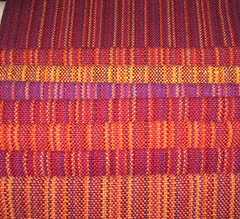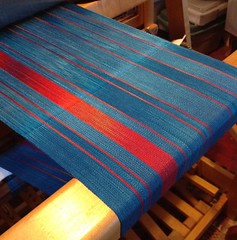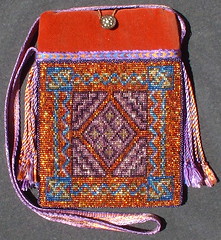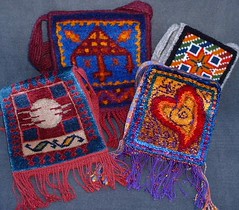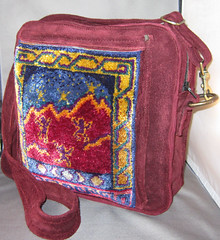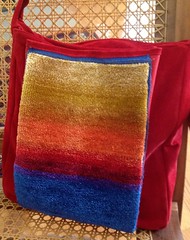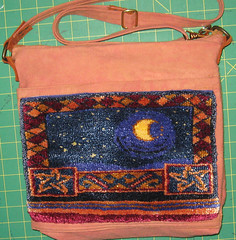Perfect
So, months, nay years ago now (May 2014) I took a cotton spinning class from Joan Ruane. (if you get a chance to take her class, do it!) At any rate, I spun some cotton, and wove the first bit up into a shawl:
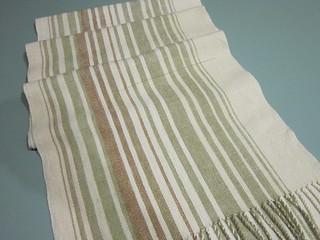
I like this shawl, the fabric is nice, it's soft and drapey, just what a shawl should be.
I wanted to make myself a jacket, in the standard style I make, and for that, I wanted a sturdier fabric. I began by spinning the cotton with more twist. When I had enough spun, I ran the warps and dyed them, theoretically a dark blue and red. BUT!!
I omitted the boiling part of the "before dyeing" with cotton. As in, I soaked the warps in very hot water with detergent, but did not boil them.
The result? was less than stellar:
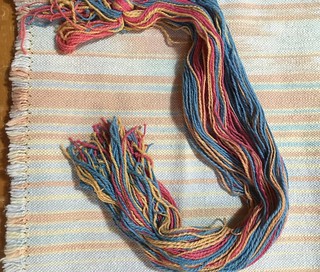
What I have left of that original color is in these thrums. The theoretical dark blue was "baby blue" and the red was decidedly pink. The gold was nice, but could not save the other colors. Ick.
I set up the warp and started weaving anyway. I tried to tell myself that I would like it woven up. I could hardly weave the thing it was so annoying. I stopped weaving, I started again, I stopped and started again and again, until finally I just got over myself wove the thing off.
I did not like it.
SO! I dipped the whole fabric in discharge solution. That's it, under the thrums, in the photo above. It was acceptable, pale colors, almost neutrals, and I could stand it. I sewed up the jacket.
Turns out, I could not wear it. Or rather, I would not wear it, never chose it to put on. Being almost all white, it just did not look good on me, too pale, too white, too, I don't know: insipid?
So yesterday, I over-dyed the whole garment:
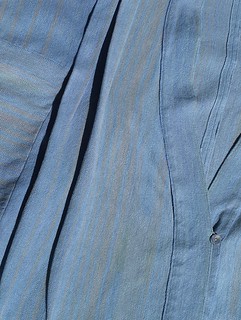
It came out a great blue: easy to wear with denim and jeans, and even the stripes of former-pink look good, subtle, but evident, and ... not pink!
Now I think I will be wearing this more. If I were standing in line at the grocery store, no one would ever guess the trauma this yarn and fabric havesendured. No one would ever really guess that this is handspun, handwoven, and (hah!) hand-dyed cotton.
Perfect!

I like this shawl, the fabric is nice, it's soft and drapey, just what a shawl should be.
I wanted to make myself a jacket, in the standard style I make, and for that, I wanted a sturdier fabric. I began by spinning the cotton with more twist. When I had enough spun, I ran the warps and dyed them, theoretically a dark blue and red. BUT!!
I omitted the boiling part of the "before dyeing" with cotton. As in, I soaked the warps in very hot water with detergent, but did not boil them.
The result? was less than stellar:

What I have left of that original color is in these thrums. The theoretical dark blue was "baby blue" and the red was decidedly pink. The gold was nice, but could not save the other colors. Ick.
I set up the warp and started weaving anyway. I tried to tell myself that I would like it woven up. I could hardly weave the thing it was so annoying. I stopped weaving, I started again, I stopped and started again and again, until finally I just got over myself wove the thing off.
I did not like it.
SO! I dipped the whole fabric in discharge solution. That's it, under the thrums, in the photo above. It was acceptable, pale colors, almost neutrals, and I could stand it. I sewed up the jacket.
Turns out, I could not wear it. Or rather, I would not wear it, never chose it to put on. Being almost all white, it just did not look good on me, too pale, too white, too, I don't know: insipid?
So yesterday, I over-dyed the whole garment:

It came out a great blue: easy to wear with denim and jeans, and even the stripes of former-pink look good, subtle, but evident, and ... not pink!
Now I think I will be wearing this more. If I were standing in line at the grocery store, no one would ever guess the trauma this yarn and fabric havesendured. No one would ever really guess that this is handspun, handwoven, and (hah!) hand-dyed cotton.
Perfect!
